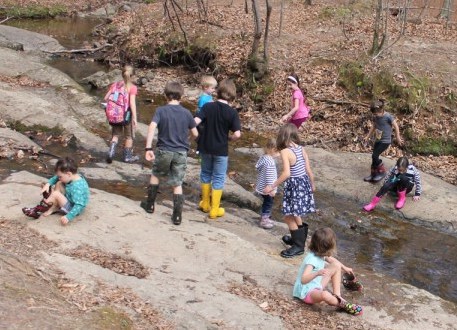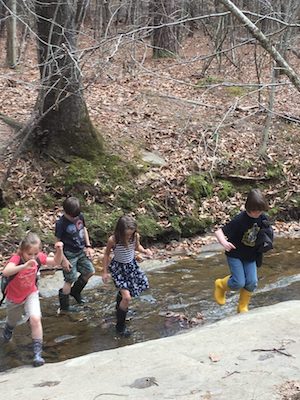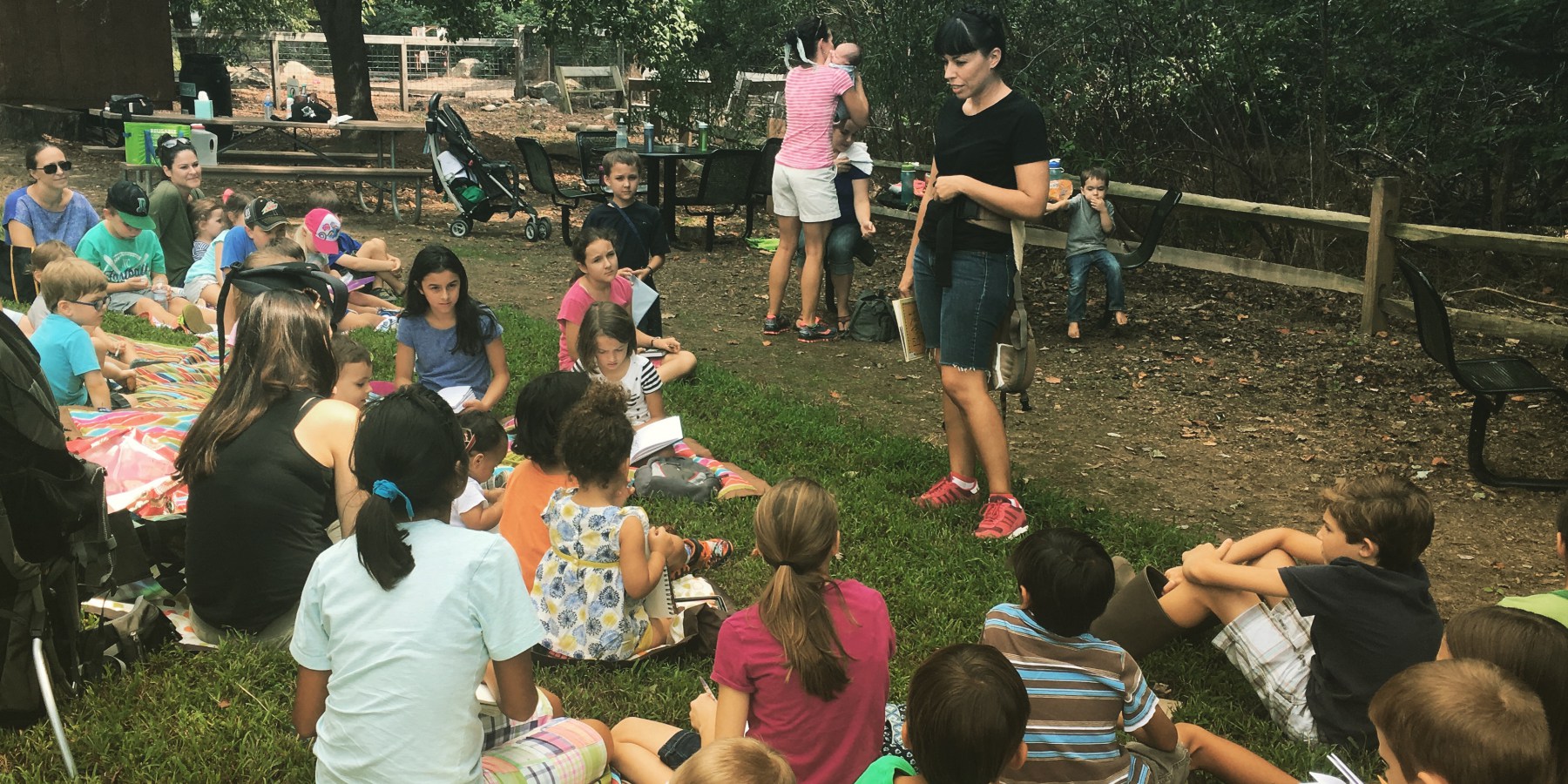Making a Charlotte Mason Community
Editor’s note: This article first appeared on Charlotte Mason Living.
In a previous post I talked about what a lovely and enriching experience it has been for our family to be part of Considering Lilies, our Charlotte Mason community. We are in our third year together and have settled into some comfortable rhythms and useful practices. Today I am going to share ideas that I hope can help a few of you establish your own Charlotte Mason communities. It seems appropriate to divide the “how to’s” into Mason’s three instruments of education; think of a your community in terms of “an atmosphere, a discipline and a life.”
Atmosphere
Before beginning, it is important to have an idea why you would want to have a community and how it should feel to be a part of this community. In my previous post, I mentioned that I am an extreme introvert. I had tried larger, casual homeschool groups and found them to be overwhelming and unwelcoming. I well remember walking into some crowded homeschool community events and feeling sick at the thought of the next few hours. We were mostly ignored by the established cliques and sometimes greeted by a well-meaning hostess who would kindly direct us to an activity table and then return to her duties. When I had the opportunity to develop my own group, it was important to me that the group be small and focused on relationship building. I wanted all members to feel welcome and at ease.
That being said, our group isn’t for everyone. It is for families committed to using Mason’s methods seriously and exclusively. It is meant to serve parents and children. From the outset, we meant to help and encourage each other. Sometimes that means carrying someone else’s baby on a nature hike or watching a few children while another mom makes an emergency run to the bathroom with her toddler. Other times it means taking the time to just listen. These are the things that were important to me and the founding members of our group. You may have other needs from your community.
Here are a few questions that you might ask yourself as you begin:
- What is the purpose of this group?
- Who is it meant to serve? Parents only? Children? The whole family?
- Should the group be large or small? Casual or committed?
- How would a new member feel at the first meeting with your group?
- Will there be a size limitation? How many people can participate and still maintain the atmosphere? Make sure you account for parents and children.
Discipline
 What I mean by discipline is in this scenario is this: decide what habits are expected of group members. Because of my previous experiences, it was important to me that right habits from parents and children be established early. Even in Christian communities, I found that there was a wide range of accepted behaviors, many of which would fall into Mason’s category of bad habits. The setup of our discussion group necessitates that the children be able to play on their own with little parental intervention. In order to do that right habits must be established at home. Clear communication for us took form in the negative. We have a list of “do-nots.” Having these established parameters and very clear expectations makes it easy for all of us to relax and enjoy our time together.
What I mean by discipline is in this scenario is this: decide what habits are expected of group members. Because of my previous experiences, it was important to me that right habits from parents and children be established early. Even in Christian communities, I found that there was a wide range of accepted behaviors, many of which would fall into Mason’s category of bad habits. The setup of our discussion group necessitates that the children be able to play on their own with little parental intervention. In order to do that right habits must be established at home. Clear communication for us took form in the negative. We have a list of “do-nots.” Having these established parameters and very clear expectations makes it easy for all of us to relax and enjoy our time together.
The other important expectation we have is related to our discussion group. Mothers must have the habit of reading the assigned chapters in Mason’s books and regularly attending discussion group. The heart of our group is our discussion. We have two real purposes. First, that we would develop relationships with other CM families and second, that we would grow in our own understanding of Mason’s work. Neither of these two purposes can be fulfilled if the mother is not discussing the reading. Mothers are required to attend five out of our eight discussion group meetings during the school year and all other events are optional, but most families attend as many events as they are able to. I believe the reason is because of our meaningful discussion time.
Relating also to discipline, we decided that it would be easiest to have one day per week set aside for our various activities. We meet on Fridays, except when field trips cannot accommodate us. The second week of the month is for field trips, the third is for nature study and the fourth is for discussion group.
Here are some logistical things that I would put in this category.
- How will you communicate as a group?
- How will you collect money for field trips and activities?
- Where will you meet? In a park, in a home or church?
- How often will you meet? Monthly, weekly?
Life
Now this is the fun part! I can tell you what we do together.
Discussion Group
I have already discussed the purpose of our group, so here I will tell you about our format. We meet once a month in the afternoon. When the weather is nice we meet at a park and when it is not so nice we are able to meet in a church. We are split into two discussion groups because there are several large families and a lot of young children, so we have found that the children do best when there are no more than about 20 of them present during the meeting. That makes for about 6 or 7 moms in each group. This makes it easy to keep the children in sight and the noise level manageable.
After greeting and setting the children, we begin with prayer. We pray for fruitful discussion, for the Holy Spirit to guide us as we learn and that the children would play well and enjoy their time without incident. Rather than using a question and answer format, we prefer to go through the reading sharing and discussing the quotes that have stood out to each of us. A small group allows for more intimate and deep discussion. With fewer voices, there is opportunity for everyone to give their own insight and to ask questions. I don’t really consider myself the leader of discussion group, but more the facilitator. When one topic has ended, I move us on to the next if necessary, but the conversation usually flows in a very natural and organic way. We move easily between philosophy and practical application, with the more experienced mothers sharing how they have already put these ideas into practice. Usually the conversation winds down after about one and a half hours, which is about the limit for masterly inactivity among the children.
We are coming to the end of our third year as a discussion group with this format. Training the children to keep themselves busy has been a process and is one that is continually evolving. My own children were quite young when we started, six, three and an infant, but there were also older children who were very helpful entertaining and keeping an eye out for the little ones. It is definitely a team effort. There are interruptions throughout the meeting, mostly from the little ones, but it hasn’t affected our ability to have rich and meaningful conversations.
Field Trips
When attending field trips, we try to keep in mind that we are representing our own group, homeschoolers in general, Charlotte Mason in particular and Christ especially. We take special care to maintain our good habits of being respectful of people and property.
 We have gone to so many fun and interesting places. Once I started searching, I was amazed at all of the possibilities. I cannot speak for other areas, but where I live, near Raleigh, North Carolina, there are many programs specifically for homeschoolers and many of them are free or very inexpensive. We have found that most places try to divide the group by age, sometimes with good reason, but we prefer to keep families together whenever we can. Because of the good habits continually exercised, the younger children usually do very well during the programs. For the ones that don’t the mother will take the child to play outside so as not to be disruptive to the others. I have been that mom waiting outside quite a few times, but my older girls are able to enjoy the field trip with the rest of the group.
We have gone to so many fun and interesting places. Once I started searching, I was amazed at all of the possibilities. I cannot speak for other areas, but where I live, near Raleigh, North Carolina, there are many programs specifically for homeschoolers and many of them are free or very inexpensive. We have found that most places try to divide the group by age, sometimes with good reason, but we prefer to keep families together whenever we can. Because of the good habits continually exercised, the younger children usually do very well during the programs. For the ones that don’t the mother will take the child to play outside so as not to be disruptive to the others. I have been that mom waiting outside quite a few times, but my older girls are able to enjoy the field trip with the rest of the group.
We have visited the natural history museum, the history museum, art museum, an artist studio, nature preserves, the botanical gardens, the arboretum, the symphony, historical homes, and more. For the most part, the docents are very enthusiastic about the subject they are presenting and they convey that, which is inspiring to the children. I have learned a lot on these field trips and I look forward to the day that I don’t have to step out with a wiggly and chatty preschooler.
Nature Study
Nature Study is an especially fun time for the group. We have tried a few different formats, but I think we have settled on the way we are currently implementing it. We pick topics at the start of the school year, based on what we can expect over the seasons. These subjects will be studied by each family through the month in addition to their other nature studies. It isn’t meant to be an entire nature study program; it’s really just for the fun of it. The subject is introduced at our nature study meeting and then studied through the month.
 Since we started, we have met at the same location to do our nature study. This allows us to be very familiar with the park and watch the effects of the change in seasons. The children know which trees are best to climb and where they can find milkweed and caterpillars. They know the trail that leads to the stream and where the violets bloom. They remember where we saw a huge black snake and which thorny tree has a bird’s nest. I hope that memories of this place will be treasured by them their whole lives. For the mothers, we know the favored places to play and where we can chat, but still keep the little ones in sight. We are able to give the older children more freedom to explore and enjoy our own time outdoors.
Since we started, we have met at the same location to do our nature study. This allows us to be very familiar with the park and watch the effects of the change in seasons. The children know which trees are best to climb and where they can find milkweed and caterpillars. They know the trail that leads to the stream and where the violets bloom. They remember where we saw a huge black snake and which thorny tree has a bird’s nest. I hope that memories of this place will be treasured by them their whole lives. For the mothers, we know the favored places to play and where we can chat, but still keep the little ones in sight. We are able to give the older children more freedom to explore and enjoy our own time outdoors.
A typical nature study meeting begins at 1:00 pm, but many of us make more of a day out of it. Most of the families with younger children, and less school work, arrive around 11:00 am for playtime. The children excitedly call out arriving families by last and the children arriving immediately join the others as soon as they are located. We, mothers, and sometimes fathers, catch up on the latest family news. A few of the children get hungry, so we spread out some picnic blankets and eat our lunch. Almost as soon as they have swallowed the last bite, sometimes before, the children run off to play again, until they are called to start our lesson.
Before introducing the next special study, I ask the children to narrate some of their observations from the previous month. They usually have some excellent things to share and I can see which children were more drawn to that particular study. For about 10 minutes I introduce our next subject. I usually start by asking the children what they already know on the subject. I try to use that as my starting point for what to introduce. I give the children an idea of what they should look for over the next few weeks and I usually introduce some terms. Then I give them a specific assignment for their nature journals. Sometimes I ask them to compare two like things, like twigs from two different trees, or two kinds of flowers that are in bloom. Other times I ask them to go on a hunt for one particular thing, like a bird nest, draw it and then write observations on shape, and size, where it was found and why that place may have been chosen. We have all ages up to 14, so the children only complete the assignment as well as they are able. The focused time for discussion and journaling is probably about 45 minutes. There is no pressure; it is just part of what we do together and everyone seems to enjoy it. Once the journal entry is completed, the children go off to play and the mothers resume their conversations.
I don’t like to refer to Considering Lilies as a co-op. A co-op isn’t what we set out to create. We needed something for the whole family, something enjoyable, flexible and enriching. A community. We all live in the real world and there are few places where we can expect our specific values to be shared. Oftentimes, even in the church, people have different ideas about raising children. Our community gatherings are a kind of retreat from our day to day trials. We are united in our Christian faith and adherence to Miss Mason’s philosophy. When we are together, we can relax. We are rejuvenated, we are refreshed and we have a lot of fun! We are enjoying life.

One Reply to “Making a Charlotte Mason Community”
This blog was written in 2017. I would love to hear an update on what the group looks like now in 2024!